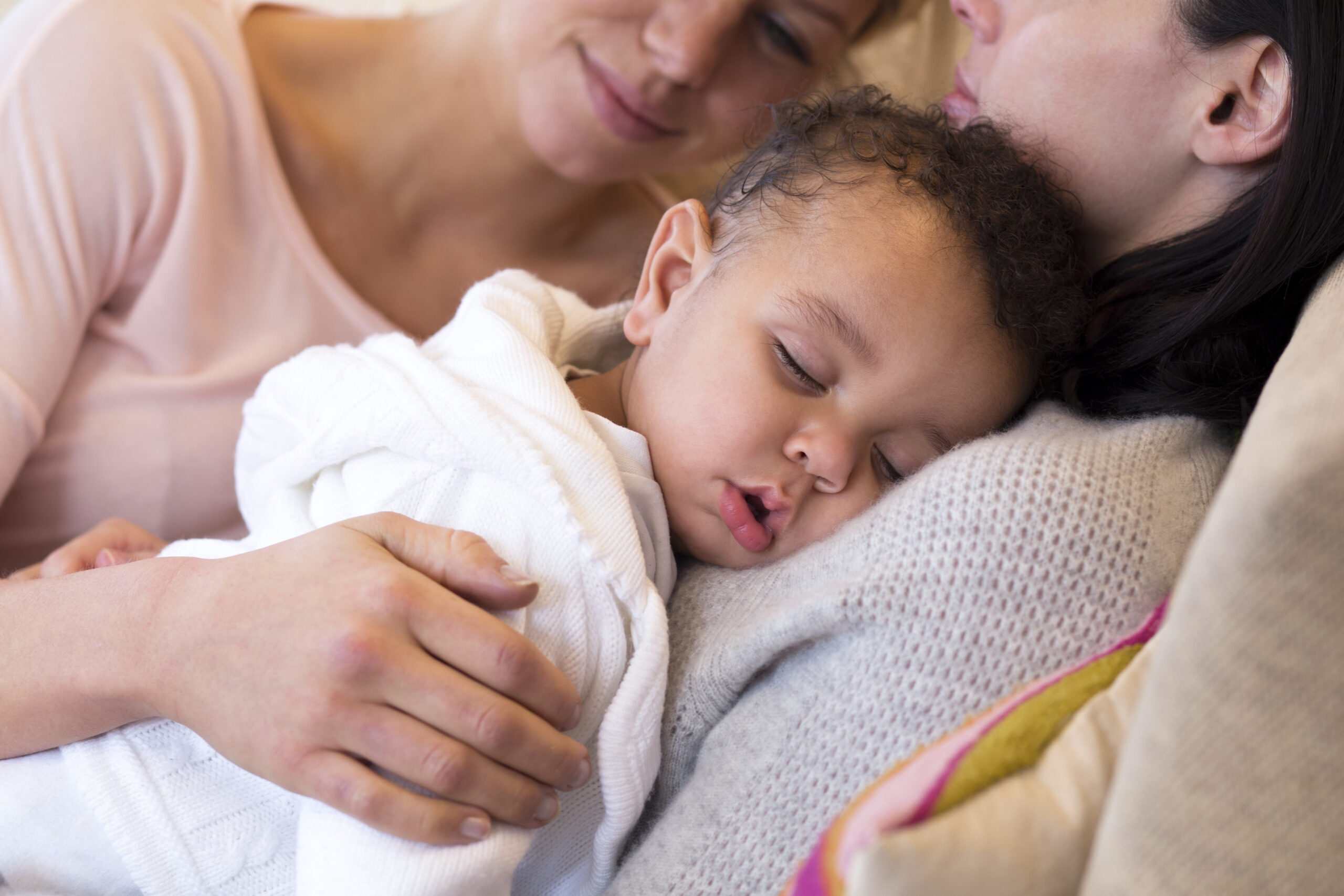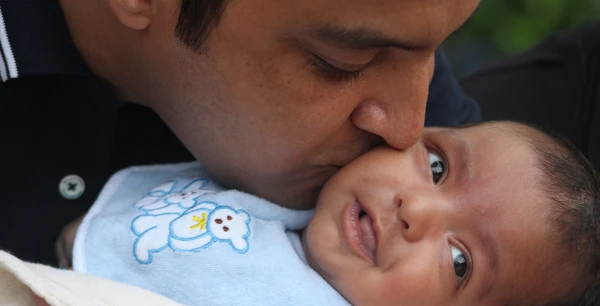At this stage, most babies need 14-17 hours of total sleep per day, including 3-4 naps. However, sleep is still developing, and nighttime wake-ups are normal. The key is to set a strong foundation for better sleep while staying flexible to meet your baby’s changing need
3-Month-Old Sample Daily Schedule
Here’s a flexible eat-play-sleep routine based on your baby’s natural rhythms:
| Time | Activity |
|---|---|
| 7:00 AM | Wake-up & feed |
| 8:15 AM | Nap #1 (1-2 hours) |
| 9:30 AM | Wake & feed |
| 10:45 AM | Nap #2 (1-1.5 hours) |
| 12:00 PM | Wake & feed |
| 1:30 PM | Nap #3 (45 min – 1.5 hours) |
| 3:00 PM | Wake & feed |
| 4:45 PM | Nap #4 (30-45 min) |
| 5:30 PM | Wake & short play |
| 6:30 PM | Wind-down & bedtime routine |
| 7:00 – 8:00 PM | Bedtime |
| 10:30 PM | Optional dream feed |
Adjust times based on your baby’s natural wake-up and nap needs.
How Much Sleep Does a 3-Month-Old Need?
At 3 months, your baby will sleep an average of 14-17 hours per day, broken down into:
- Nighttime sleep: 9-10.5 hours (not always continuous)
- Daytime naps: 4-6 hours, across 3-4 naps
According to research, babies at this age experience more structured nighttime sleep and start having longer stretches between wake-ups (Hirshkowitz et al., 2015). However, every baby is different, and sleep needs can vary. Some may still wake frequently at night, while others might start sleeping for 5-6 hour stretches.
If your baby’s sleep seems inconsistent, that’s normal! Developmental leaps, growth spurts, and feeding needs still impact sleep at this stage
What to Expect from a 3-Month-Old’s Sleep Patterns
At 3 months, babies are:
- Sleeping longer stretches at night (but still waking for feeds)
- Taking 3-4 naps per day, typically lasting 30 minutes to 2 hours
- Staying awake for 1.5-2 hours between sleep periods
- Becoming more social and interactive during wake times
- Developing a stronger circadian rhythm (internal body clock)
Common Sleep Developments at This Age:
- More defined sleep cycles: Your baby starts experiencing lighter and deeper sleep stages, which can lead to shorter naps and brief night wakings.
- Increased alertness: Your baby is more engaged in the world, which means they may need more active wind-down time before sleep.
- Longer sleep stretches at night: Some babies naturally begin sleeping 5-6 hours at a time, though night wakings are still expected.
Tip: Start laying the groundwork for independent sleep by placing your baby down drowsy but awake at bedtime when possible.
3-Month-Old Nap Schedule: How Many Naps & How Long?
At 3 months, babies typically take 3-4 naps per day, totaling about 4-6 hours of daytime sleep.
| Nap | Typical Duration |
|---|---|
| Morning Nap | 1-2 hours |
| Midday Nap | 1-1.5 hours |
| Afternoon Nap | 45 min – 1.5 hours |
| Late Afternoon Nap | 30-45 min (may start shortening) |
First nap of the day tends to be the longest.
The last nap of the day should end by 6:00 PM to avoid interfering with bedtime.
Some days, naps may be short (30-45 minutes), and that’s okay! Babies this age are still transitioning between short naps and longer consolidated sleep.
Wake Windows for a 3-Month-Old
A wake window is the amount of time your baby can comfortably stay awake before needing to sleep again.
At 3 months, most babies can stay awake for 1.5 to 2 hours before needing another nap (Devnani, 2010).
| Wake Window | When to Expect It |
|---|---|
| 1.5 hours | After morning wake-up |
| 1.5 – 2 hours | Before each nap |
| 2 hours max | Before bedtime |
? Tip: Watching for sleepy cues (yawning, rubbing eyes, zoning out) is more reliable than following a strict clock-based schedule.
3-Month-Old Bedtime Routine
A consistent bedtime routine helps signal to your baby that it’s time to sleep. Keep it calm, predictable, and about 30-45 minutes long.
? Example Bedtime Routine:
- Dim the lights and lower stimulation
- Bath or gentle wipe-down
- Massage & pajamas
- Quiet feed (keep lights low)
- Lullaby or story
- Into crib drowsy but awake
Lay your baby down drowsy but awake to help them learn self-soothing skills over time.
Common Sleep Challenges at 3 Months & Solutions
- Short Naps – If your baby is only sleeping 30-45 minutes, they may need help linking sleep cycles. Try holding them for a few minutes after waking or offering gentle reassurance to extend naps
- Early Morning Wakings (before 6 AM) – Ensure room is dark, use white noise, and keep bedtime consistent
- Fussy at Bedtime – Overstimulation can cause difficulty winding down. Start bedtime earlier and introduce a calming wind-down routine.
- Overtiredness – Skipping naps can lead to fussiness and difficulty falling asleep. Watch wake windows and adjust bedtime earlier if needed.
Can a 3-Month-Old Sleep Through the Night?
Some babies may sleep 6-8 hours straight, but most still need at least 1-2 night feedings.
By 4-6 months, many babies start naturally consolidating nighttime sleep if given the opportunity to practice self-soothing.
Final Thoughts: Laying the Foundation for Healthy Sleep
At 3 months, your baby’s sleep is still developing, but gentle consistency now will pay off later. Focus on:
- Setting a predictable routine
Watching wake windows and sleepy cues
Practicing “drowsy but awake” at bedtime
Being patient with short naps & night wakings
Your baby is learning how to sleep well, and you’re doing an amazing job guiding them!
Citations
- Holliday-Bell, Angela . “A Parent’s Guide to Sleep Training Infants and Toddlers – UChicago Medicine.” UChicago Medicine, 24 May 2023, www.uchicagomedicine.org/forefront/pediatrics-articles/2023/may/sleep-training-in-infants-and-toddlers.
- Willumsen, J., & Bull, F. (2020). Development of WHO Guidelines on Physical Activity, Sedentary Behavior, and Sleep for Children Less Than 5 Years of Age.. Journal of physical activity & health, 17 1, 96-100 . https://doi.org/10.1123/jpah.2019-0457.
- Daphna Yasova Barbeau et al. “Sleep Disturbances in Newborns.” Children, 4 (2017). https://doi.org/10.3390/children4100090.
- J. Mindell, E. Leichman, Jordana W. Composto, Christina Lee, Bula Bhullar and R. Walters. “Development of infant and toddler sleep patterns: real‐world data from a mobile application.” Journal of Sleep Research, 25 (2016). https://doi.org/10.1111/jsr.12414.
- M. Hirshkowitz, M. Hirshkowitz, Kaitlyn Whiton, S. Albert, C. Alessi, O. Bruni, L. Doncarlos, Nancy L Hazen, J. Herman, E. Katz, L. Kheirandish-Gozal, D. Neubauer, A. O’donnell, M. Ohayon, J. Peever, R. Rawding, R. Sachdeva, B. Setters, MICHAEL V. Vitiello, J. Ware and P. Hillard. “National Sleep Foundation’s sleep time duration recommendations: methodology and results summary..” Sleep health,
1 1 (2015): 40-43 . https://doi.org/10.1016/j.sleh.2014.12.010.
- I. St James-Roberts, Marion Roberts, Kimberly Hovish and C. Owen. “Video Evidence That London Infants Can Resettle Themselves Back to Sleep After Waking in the Night, as well as Sleep for Long Periods, by 3 Months of Age.” Journal of Developmental and Behavioral Pediatrics, 36 (2015): 324 – 329. https://doi.org/10.1097/DBP.0000000000000166.
- P. Devnani. “Paediatric sleep medicine.” The Indian Journal of Sleep Medicine, 5 (2010): 105-110. https://doi.org/10.5005/IJSM-5-4-105.
- SADEH, A., MINDELL, J.A., LUEDTKE, K. and WIEGAND, B. (2009), Sleep and sleep ecology in the first 3 years: a web-based study. Journal of Sleep Research, 18: 60-73. https://doi.org/10.1111/j.1365-2869.2008.00699.x
- McGraw, Kate, Robert Hoffmann, Chris Harker and John H. Herman. “The development of circadian rhythms in a human infant.” Sleep 22 3 (1999): 303-10. https://doi.org/10.1093/SLEEP%2F22.3.303
- S. Paruthi, L. Brooks, C. D’Ambrosio, W. Hall, S. Kotagal, Robin M. Lloyd, B. Malow, K. Maski, C. Nichols, S. Quan, C. Rosen, M. Troester and M. Wise. “Recommended Amount of Sleep for Pediatric Populations: A Consensus Statement of the American Academy of Sleep Medicine..” Journal of clinical sleep medicine : JCSM : official publication of the American Academy of Sleep Medicine, 12 6 (2016): 785-6 . https://doi.org/10.5664/jcsm.5866.
- R. Spencer and Tracy Riggins. “Contributions of memory and brain development to the bioregulation of naps and nap transitions in early childhood.” Proceedings of the National Academy of Sciences of the United States of America, 119 (2022). https://doi.org/10.1073/pnas.2123415119.
- Stanford Children’s Health. “Infant Sleep.” Stanford Medicine, 2019. https://www.stanfordchildrens.org/en/topic/default?id=infant-sleep-90-P02237.
- S. Hanafin. “Sleep patterns and problems in infants and young children in Ireland.” Child: Care, Health and Development, 44 (2018): 470–475. https://doi.org/10.1111/cch.12539.




